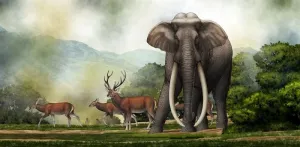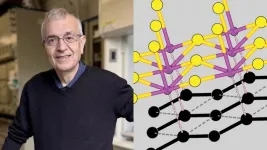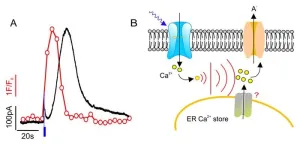(Press-News.org) During the late middle Pleistocene, between 300 and 400 thousand years ago, at least three ancient elephant relatives died near a river in the Kashmir Valley of South Asia. Not long after, they were covered in sediment and preserved along with 87 stone tools made by the ancestors of modern humans.
The remains of these elephants were first discovered in 2000 near the town of Pampore, but the identity of the fossils, cause of death and evidence of human intervention remained unknown until now.
A team of researchers including Advait Jukar, a curator of vertebrate paleontology at the Florida Museum of Natural History, published two new papers on fossils from the Pampore site. In one, researchers describe their discovery of elephant bone flakes which suggests that early humans struck the bones to extract marrow, an energy-dense fatty tissue. The findings are the earliest evidence of animal butchery in India.
The fossils themselves are also rare. In a second study the researchers described the bones, which belong to an extinct genus of elephants called Palaeoloxodon, whose members were more than twice the weight of today’s African elephants. Only one set of Palaeoloxodon bones for this species had been discovered previously, and the fossils from this study are by far the most complete.
To date, only one fossil hominin — the Narmada human — has ever been found on the Indian subcontinent. Its mix of features from older and more recent hominin species indicate the Indian subcontinent must have played an important role in early human dispersal. Prior to the fossil’s discovery in 1982, paleontologists only had stone tool artifacts to give a rough sketch of our ancestors’ presence on the subcontinent.
“So, the question is, who are these hominins? What are they doing on the landscape and are they going after big game or not?” Jukar asked. “Now we know for sure, at least in the Kashmir Valley, these hominins are eating elephants.”
The stone tools likely used for marrow extraction at the Pampore site were made with basalt, a type of rock not found in the local area. Paleontologists believe the raw materials were brought from elsewhere before being fully knapped, or shaped, at the site. Based on the method of construction, they concluded that the site and the tools were 300,000 to 400,000 years old.
Previously, the earliest evidence of butchery in India dated back less than ten thousand years.
“It might just be that people haven’t looked closely enough or are sampling in the wrong place,” Jukar said. “But up until now, there hasn’t been any direct evidence of humans feeding on large animals in India.”
Most of the Pampore site’s elephant remains came from one mature male Palaeoloxodon. The inside of its skull showed abnormal bone growth that likely resulted from a chronic sinus infection.
While it was clear that early humans exploited the carcass, there was no direct evidence of hunting, such as spear points lodged in the bones. The hominins could have killed the elephant or simply found the carcass after it died of natural causes — weakened by its chronic sinus infection, the elephant could possibly have gotten stuck in the soft sediments near the Jhelum River, where paleontologists eventually found it.
The Palaeoloxodon skull is the most complete specimen of its genus found on the Indian subcontinent. Researchers identified it as belonging to the extinct elephant Palaeoloxodon turkmenicus, fossils of which have only been found on one other occasion, in 1955. This earliest fossil was of a partial skull fragment from Turkmenistan. While it looked different from other members of the genus Palaeoloxodon, there wasn’t enough material to determine with certainty whether it was, in fact, a separate species.
“The problem with Palaeoloxodon is that their teeth are largely indistinguishable between species. So, if you find an isolated tooth, you really can’t tell what species of Palaeoloxodon it belongs to,” Jukar said. “You have to look at their skulls.”
Fortunately, the Pampore specimen’s hyoids — bones at the back of the throat that attach to the tongue — were still intact. Hyoids are fragile but distinctive between species, providing a special tool for taxonomizing.
Palaeoloxodon originated in Africa about a million years ago before dispersing into Eurasia. Many species in the genus are known for having an unusually large forehead unlike that of any living elephant species, with a crest that that bulges out over their nostrils. Earlier species of Palaeoloxodon from Africa, however, do not have the bulge. Meanwhile, P. turkmenicus is somewhere in between, with an expanded forehead with no crest.
“It shows this kind of intermediate stage in Palaeoloxodon evolution,” Jukar said. “The specimen could help paleontologists fill in the story of how the genus migrated and evolved.”
Given that hominins have been eating meat for millions of years, Jukar suspects that a lot more evidence of butchery is simply waiting to be found.
“The thing I’ve come to realize after many years is that you just need a lot more effort to go and find the sites, and you need to essentially survey and collect everything,” he said. “Back in the day when people collected fossils, they only collected the good skulls or limb bones. They didn’t collect all the shattered bone, which might be more indicative of flakes or breakage made by people.”
The stone tool and elephant butchery study was published in Quaternary Science Reviews.
The taxonomy study was published in the Journal of Vertebrate Paleontology.
END
Rare fossils of extinct elephant document the earliest known instance of butchery in India
2024-10-21
ELSE PRESS RELEASES FROM THIS DATE:
Argonne materials scientist Mercouri Kanatzidis wins award from American Chemical Society for Chemistry of Materials
2024-10-21
Mercouri Kanatzidis, a materials scientist at the U.S. Department of Energy’s Argonne National Laboratory and professor at Northwestern University, will receive the 2025 ACS Award in the Chemistry of Materials from the American Chemical Society, the nation’s leading professional organization of chemists.
The award “recognizes and encourages creative work in the chemistry of materials,” according to the citation.
At Argonne, Kanatzidis’s work has focused on the implications of a ...
Lehigh student awarded highly selective DOE grant to conduct research at DIII-D National Fusion Facility
2024-10-21
When it comes to sustainable energy, harnessing nuclear fusion is—for many—a holy grail of sorts. Unlike climate-warming fossil fuels, fusion offers a clean, nearly limitless source of energy by combining light atomic nuclei to form heavier ones, releasing vast amounts of energy in the process.
But it isn’t easy replicating and controlling the process that powers the sun.
“We eventually want to move to producing energy this way,” says Brian Leard ’21 ’25G, a ...
Plant guard cells can count environmental stimuli
2024-10-21
Plants control their water consumption via adjustable pores (stomata), which are formed from pairs of guard cells. They open their stomata when there is a sufficient water supply and enough light for carbon dioxide fixation through photosynthesis. In the dark and in the absence of water, however, they initiate the closing of the pores.
SLAC/SLAH-type anion channels in the guard cells are of central importance for the regulation of the stomata. This has been shown by the group of Professor Rainer Hedrich, biophysicist at Julius-Maximilians-Universität ...
UAMS researchers find ground beef packs bigger muscle-building punch than soy-based alternative
2024-10-21
When it comes to building muscle, not all proteins are created equal.
New research from the University of Arkansas for Medical Sciences (UAMS) reveals that 100% ground beef packs a bigger punch for muscle protein synthesis than a soy-based counterpart. In fact, the study suggests that a person would need double the amount of soy-based protein to achieve the same results.
Published in the American Journal of Clinical Nutrition, the study examined the anabolic response — how the body builds muscle — after consuming a 4-ounce beef patty versus one or two 4-ounce patties of a soy-based product. The results? Just one serving of beef did the ...
Study: AI could transform how hospitals produce quality reports
2024-10-21
A pilot study led by researchers at University of California San Diego School of Medicine found that advanced artificial intelligence (AI) could potentially lead to easier, faster and more efficient hospital quality reporting while retaining high accuracy, which could lead to enhanced health care delivery.
The study results, published in the October 21, 2024 online edition of the New England Journal of Medicine (NEJM) AI, found an AI system using large language models (LLMs) can accurately process hospital quality measures, ...
Four U-M faculty elected to National Academy of Medicine
2024-10-21
Four University of Michigan faculty have been elected to the National Academy of Medicine, one of the highest honors in medical research.
Kenneth M. Langa, M.D., Ph.D., Erica E. Marsh, M.D., MSCI, FACOG, Santa J. Ono, Ph.D. and Marc A. Zimmerman, Ph.D., are among 100 newly elected health and medical scientists recognized for their outstanding professional achievement and commitment to service.
They join the 79 other current, former and late U-M faculty who have earned this distinction. NAM members help the Congressionally chartered, private nonprofit organization provide objective advice to the nation on key health ...
FSU College of Medicine research team connects loneliness with heightened risk of dementia in largest study of its kind
2024-10-21
New research led by Florida State University College of Medicine faculty quantified the association between loneliness and dementia by analyzing data from more than 600,000 people around the world — the largest study of its kind.
The meta-analysis of 21 longitudinal studies showed that experiencing feelings of loneliness increased the risk of developing dementia by 31%. The research was published in Nature Mental Health.
“These results are not surprising, given the mounting evidence that link loneliness to poor health,” said Assistant Professor Martina Luchetti, who led the study. “Dementia ...
Berry studying nitrogen vacancy diamond metrology for temperature and pressure sensing
2024-10-21
Tyrus Berry, Assistant Professor, Mathematics, College of Science, received funding for the project: “Nitrogen Vacancy Diamond Metrology for Temperature and Pressure Sensing: Data Assimilation.”
Berry aims to provide the mathematical tools for a robust sensor that can simultaneously measure temperature, pressure, and force over a long range of values in harsh environments.
The sensor readings will be tied to fundamental physics laws, and the mathematical framework will automatically track any drift in the ...
Antil studying structure preserving optimization algorithms and digital twins
2024-10-21
Antil Studying Structure Preserving Optimization Algorithms & Digital Twins
Harbir Antil, Professor, Mathematical Sciences, College of Science, received funding from the National Science Foundation to study partial differential equation (PDE)-constrained optimization problems that incorporate data to make decisions in the presence of uncertainty arising from modeling unknown quantities.
The proposed methods support various application areas, including digital twins where physics and data are fused to support decision making.
One graduate student will be supported by the project and the ...
Yang developing integrated evaluation cyberinfrastructure towards safe a dependable autonomous driving systems
2024-10-21
Lishan Yang, Assistant Professor, Computer Science, College of Engineering and Computing (CEC), received funding for the project: “Collaborative Research: Elements: MELIOREM: An Integrated Evaluation Cyberinfrastructure towards Safe and Dependable Autonomous Driving Systems.”
Yang and her collaborators aim to develop MELIOREM, an automated tool designed to enhance the safety of autonomous vehicles.
MELIOREM will conduct rigorous testing to identify and address potential safety issues before they affect public roads. This initiative ensures that autonomous vehicles are dependable ...




